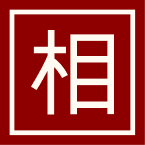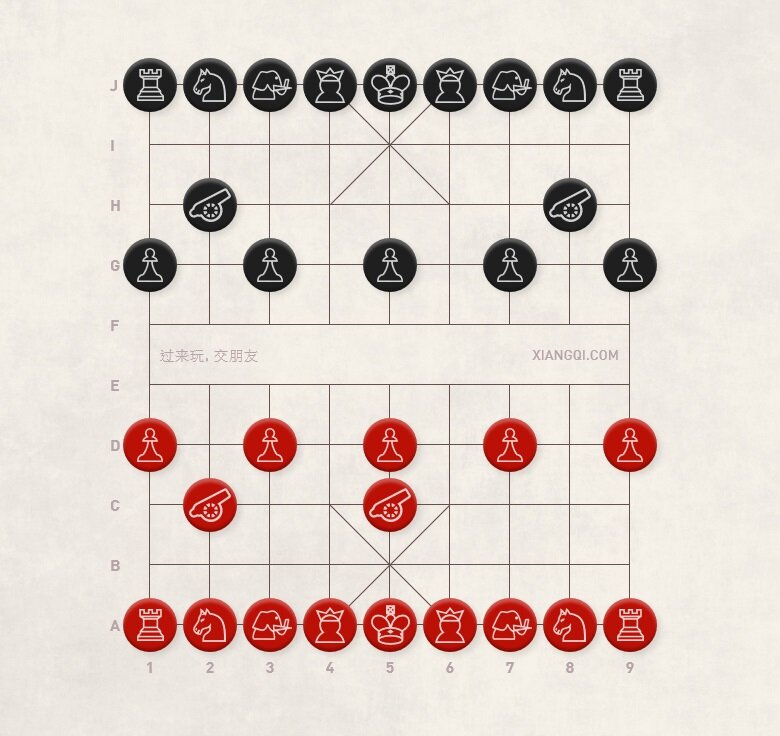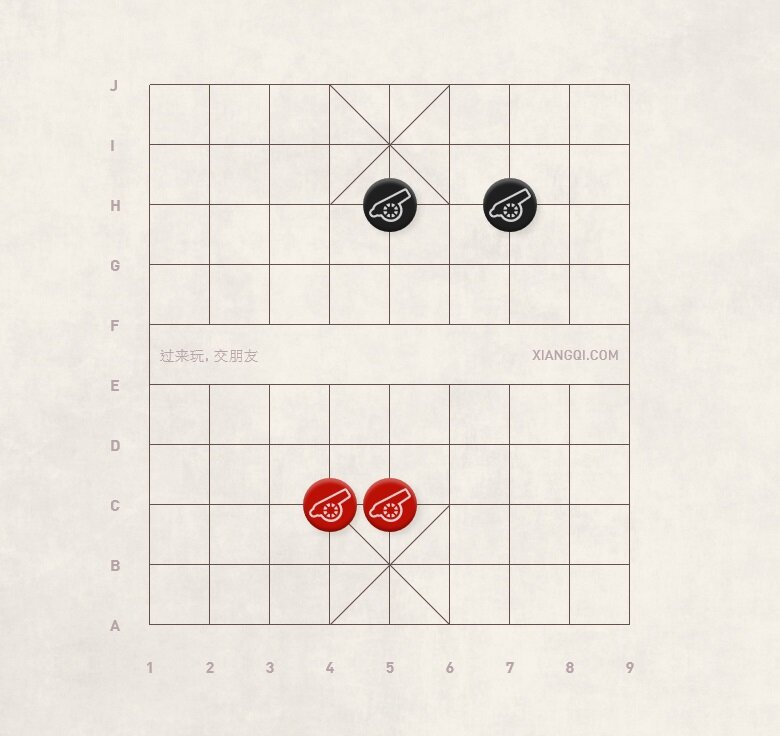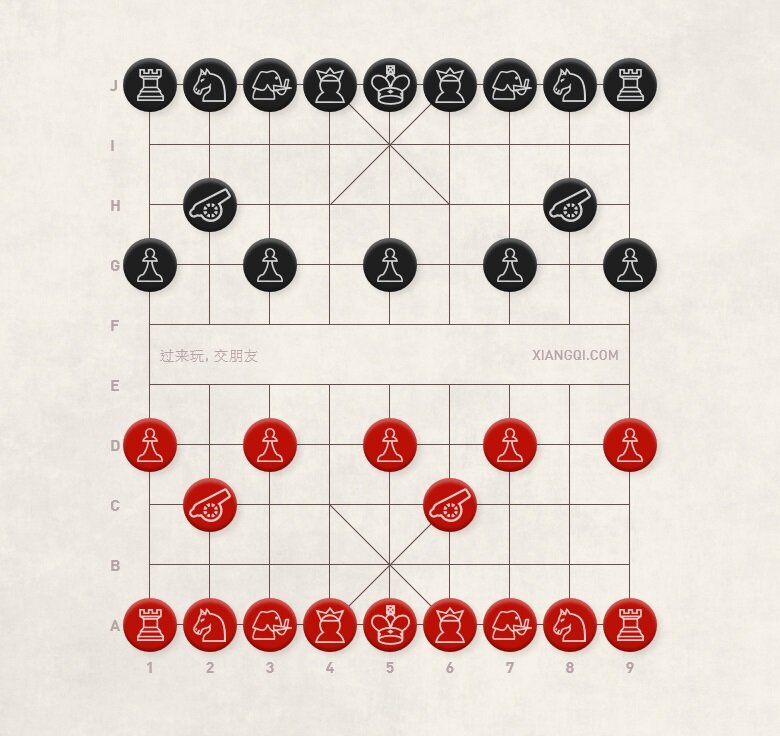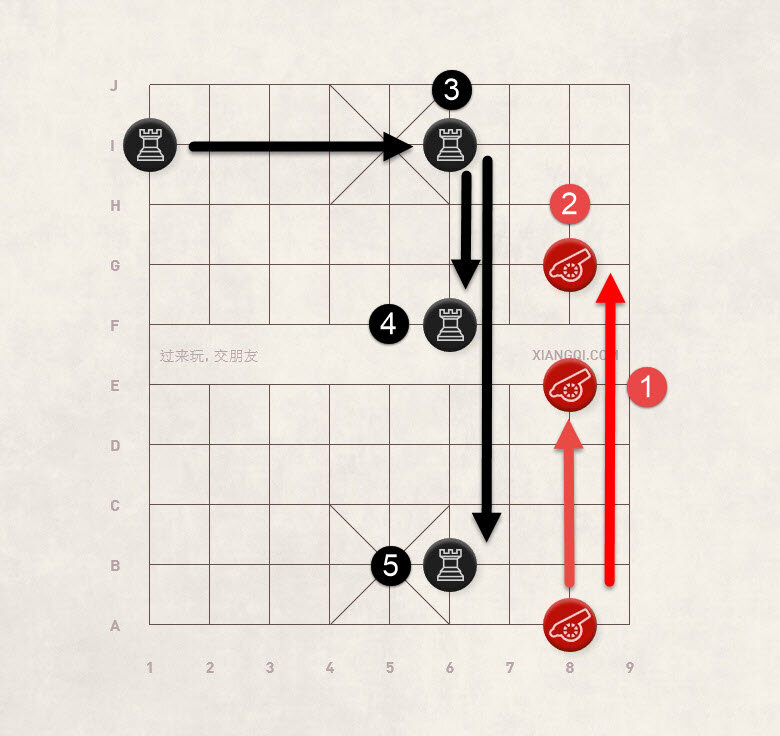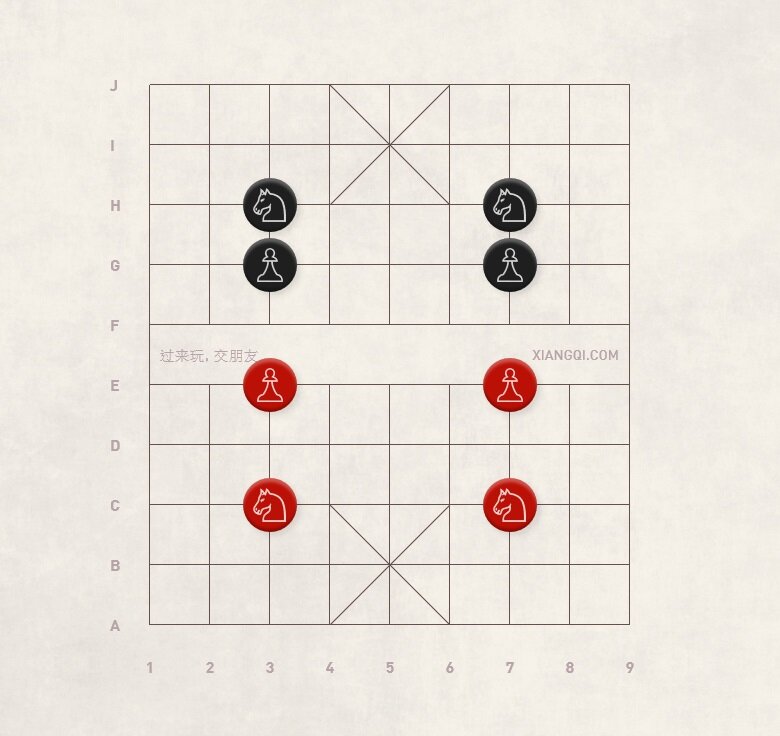Glossary of Basic Xiangqi (Chinese Chess) Opening Terms
Author: Jim Png from XqInEnglish
The Opening Phase in Xiangqi (Chinese Chess) is one of the phases of Xiangqi where most newcomers are interested. However, to really understand the opening phase, a short introduction to the terminology is necessary.
When the author was writing the Lexicon of Xiangqi (Chinese Chess) in English, one of the sections with the most content was the openings section. The following is a compilation of basic opening terms that are considered to be essential knowledge.
This article is divided into the following sections.
Development of the Cannon
Central Cannon Opening. 中炮 (zhōng pào) 当头炮 (dāng tóu pào)
Red plays C2=5 or C8=5 for the first move. It has been the opening of choice for the past few centuries. It accounts for approximately half of all the openings played. Even other openings like the Pawn and Horse Opening often transposition back to this opening system.
Diagram 1 Central Cannon Opening.
Many formations make use of the Central Cannon: the 56 Cannons (五六炮 wǔ liù pào), the 57 Cannons (五七炮 wǔ qī pào), the 58 Cannons (五八炮 wǔ bā pào), the 59 Cannons (五九炮 wǔ jiǔ pào), the Central Cannon with Pawn Ranked Cannon which is also called the 58 Cannons, and the Central Cannon with Riverbank Cannon Variation (中炮巡河炮zhōng pào xún hé pào).
Note:
a) The integers represent the files on which the Cannons are located, and DO NOT REFER TO THE TOTAL NUMBER OF CANNONS!
b) Even if the Cannons are located on the 4th and 5th files, it would still be called the 56 Cannons by default. The same would apply for the 53 Cannons (57 Cannons), 52 Cannons (58 Cannons), and 51 Cannons (59 Cannons).
Diagram 2 Red and Black's 56 Cannons with different development of the Horses
Diagram 3 Red's 58 Cannons and Black's 59 Cannons
The left Cannon in the 58 Cannons is usually further developed as C8+2 or C8+4. When it is developed as C8+2, it is called the Central Cannon with Riverbank Cannon Variation. If it is developed as C8+4, it is called the Central Canon with Pawn-ranked Cannon Variation or simply the 58 Cannons.
Diagram 4 Red's Central Cannon with Riverbank Cannon, Black's Central Cannon with Pawn Ranked Cannon
Other Orthodox Cannon Openings include the Palcorner Cannon Opening (士角炮 shì jiǎo pào) and the Cross-Palace Cannon Opening (过宫炮 guò gōng pào).
Diagram 5 Palcorner Cannon Opening. C2=4
Diagram 6 Cross Palace Cannon Opening, C2=6
Development of the Horse
Many terms are used to describe the Horse at various positions. These terms differ from the terms used in the multiple attacks like the Elbow Horse Checkmate, et cetera. The terms listed below refer only to the names of the Horse in the opening.
For the first move, the Horse can only be developed as a Proper Horse (正马 zhèng mǎ, 2), Edge Horse (边马 biān mǎ, 3), or E-eye Horse (拐角马 guǎi jiǎo mǎ, 1).
For the Horse to be developed as an E-eye Horse, the adjacent Elephant as not be moved away. The E-eye Horse was given in a very early list of terms by the AXF (Asian Xiangqi Federation) as the Horse occupied the Elephant's Eye.
Diagram 7 Development of the Horse, 1st move
The Horse is further developed as the game continues. As a continuation of the diagram given above, for its second move, the Proper Horse is developed as thus:
a) H3+4 to become the Riverbank Horse (盘河马pán hé mǎ),
b) H3+2 to become the External Rib Horse (外肋马pán hé mǎ or simply 外马),
c) H3+5. Usually, both the Horses are linked, and they are called Centrally Linked Horses (盘头马 pán tóu mǎ), or
d) H3-5 to become the Centroid Horse (窝心马 wō xīn mǎ).
Sometimes, if the Horse is developed very quickly to the riverbank, say by the 3rd or 4th move, it is called a Trailblazer Horse (先锋马 xiān fēng mǎ) to stress the rapid development of the Horse.
Diagram 8 Development of the Proper Horse
1: Centroid Horse.
2. Central Linked Horses
3. Riverbank Horse/ Trailblazer Horse
4. External Rib Horse
The Edge Horse is usually developed to the Riverbank to become the External Rib Horse.
The E-eye Horse is usually further developed as the Cross-Palace Horse (穿宫马 chuān gōng mǎ) and the Tiger Headed Horse (虎头马 hǔ tóu mǎ).
Diagram 9 Further development of the E-eye Horse
1. Cross Palace Horse.
2. Tiger Headed Horse.
Development of the Chariot
The development of the Chariot is crucial in the Opening Phase. For its first move, the Chariot is usually developed as a Ranked Chariot (横车 héng jū) or a Filed Chariot (直车 zhí jū). Sometimes, the development of the Chariot might be deferred in specific variations, and it may be developed as an Elephant Chariot (象位车 xiàng wèi jū) or a King-side Chariot (贴身 tiē shēn jū).
Note: The Chinese pronunciation of the Chariot is jū, not chē.
Diagram 10 Commonly seen methods of Development of the Chariot for its first move
Legend:
1. Ranked Chariot.
2. Filed Chariot.
3. Elephant Chariot.
4. King-side Chariot.
The Filed Chariot or Ranked Chariot is further developed as the game goes on.
Diagram 11 Further development of the Filed Chariot (Red) and Ranked Chariot (Black)
Legend:
1. Riverbank Chariot (巡河车 xún hé jū).
2. Pawn Ranked Chariot (过河车 guò hé jū).
3. Cross-palace Ranked Chariot (过宫横车 guò gōng héng jū).
4 and 5 represent common intersections of development of the Ranked Chariot. There are no specific names to the author's knowledge.
There is an unorthodox opening whereby Red plays R1+1 for the Ranked Chariot as the first move, thereby offering the Horse as a sacrifice. This opening is called the Chariot Opening (铁滑车 tiě huá chē). For an even wilder version, both Chariots are developed as Ranked Chariots within the first two to three moves for the Double Ranked Chariots Opening. Such an opening is played as Red attempts a pseudo-sacrifice, hoping to claim back lost material quickly.
Development of the Pawn
The Pawn Opening (挺兵/进兵/仙人指路 tǐng bīng/jìn bīng/xiān rén zhǐ lù) is defined, by default as playing P3+1 or P7+1. It is considered an orthodox opening and has become very popular, being the second most commonly played opening in Xiangqi in tournaments. There is a poetic name to the opening called 仙人指路, which translated directly, would mean that a deity was pointing the way. This opening has been translated as Predicting Prophet in the past (HT Lau) and Angel's Pawn by other early writers.
The Edge Pawn Opening is considered unorthodox as Red plays P9+1 or P1+1 for his first move. If P9+1 is played, it is called the Nine-tailed Tortoise Opening (九尾龟 jiǔ wěi guī). If P1+1 is played, it is called the One-Horned Monster Opening (独角兽 dú jiǎo shòu).
Playing P5+1 as the first move is rarely seen. There is a name for it that the author has only seen in one article.
In the opening phase, the Pawns on the 3rd or 7th files are especially important because they allow for the development of the Horse in the same file. It has other implications too. For example, if Red gets to push P3+1, any Black Horse in the same file would have trouble developing. Hence, in many opening systems and variations, the advanced Pawn is also included in the name to refer to a specific variation. For example, the Central Cannon with 3rd Pawn Advancement vs. Screen Horse Defense and the Central Cannon with 7th Pawn Advancement vs. Screen Horse Defense Opening systems are two major opening systems in Xiangqi.
If both the 3rd and 7th Pawns are advanced, it is called the Double Headed Snake Pawns (两头蛇 liǎng tóu shé).
Diagram 12 Red's Double Headed Snake Pawns.
Development of the Elephant and Advisors
The development of the Elephant and Advisors plays a less significant role concerning the other major pieces in the opening phase. Usually, the piece that is moved is named in relation to the color. For example, the Screen Horse Defense with 3rd Pawn Advancement Variation and Left Elephant would mean Black had moved E7+5 instead of E3+5, which would have drastically different consequences.
References
1. 屠, 景明 and 杨, 柏伟. 象棋词典. 上海 : 上海文华出版社, 2009. 978-7-80740-339-5/G。475.
2. 王, 贵龙. 象棋名词术语手册. 呼和浩特 : 远方出版社, 2000. 7-80595-652-9.
3. Png, Jim Hau Cheng. Lexicon of Xiangqi (Chinese Chess) Terms in English. Taipei : Jim Png Hau Cheng, 2017. 978-957-43-4707-0.
4. 刘, 殿中. 象棋新编教程 象棋布局精要. 北京 : 北京体育大学出版社, 2000. 7-81051-486-5/G.416.
5. —. 象棋新编教程 象棋初学门径. 北京 : 北京体育大学出版社, 2000. 7-81051-484-9.

